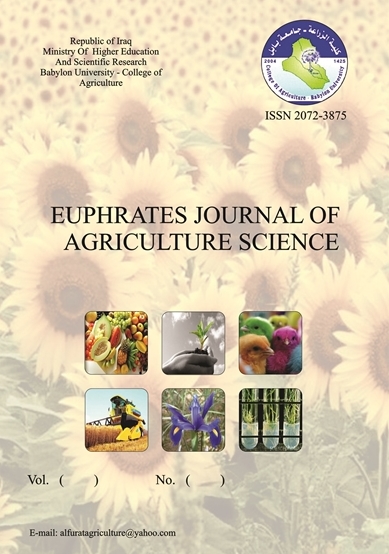Abstract
This study aimed to evaluate the efficiency of the living fungi (Tv) Trichoderma viride and (Pc) Penicillium commune, the bacteria (Pf) Pesudomonas fluorescens pf.DS and the fungicide Dazim and their interactions in controlling powdery mildew disease in cucumber plants, induction of systemic resistance and identification of control agent .The results of the pathogenicity test of the powdery mildew fungus obtained from infected cucumber plants in greenhouses showed a pathogenic potential, where the percentage of infection severity was 45.02%. The results of the antagonism between the bio control fungi T. viride and P. commune also showed an equal antagonistic ability among them, as the degree of antagonism reached (3) according to the Bell scale.While the results showed the inhibition of P. fluorescens pf.DS for the living fungi T. viride and P. commune, which amounted to 56.11 and 55%, respectively. The results showed the effect of bio agents and the fungicide Dazim and their interactions, as the severity of infection decreased in the treatment of the Dazim, reaching 17.48%. It was followed by the treatments Tv + Pc + Pf, Pc + Pf, Tv + Pf, Tv + Pc, Pf, Pc and Tv, which ranged between 22.43 and 27.38% compared to the control treatment of 70.64%. The results of the study showed that the rate of peroxidase enzyme activity increased significantly in cucumber plants treated with powdery mildew, where the treatments Dazim and Tv+Pc+Pf gave the highest enzyme activity, which amounted to 7.100 and 6,610 units/g fresh weight, respectively, compared to the control treatment, which amounted to 0.802. unit/g fresh weight. The results showed the effect of different treatments in inducing polyphenol oxidase enzyme in cucumber plants treated with powdery mildew. The results showed the effect of different treatments on increasing the percentage of phosphorous element in the content of leaves of cucumber plants treated with powdery mildew, as the fungicide treatments Dazim and Tv + Pc + Pf gave the highest percentage, reaching 0.592 and 0.528%, respectively, compared to the control treatment of 0.248%.The results also showed an effect on the percentage of potassium in the content of the leaves of cucumber plants treated with powdery mildew, where it reached the highest in the treatments Dazim, Tv + Pc + Pf, Tv + Pf, Pc + Pf and Tv + Pc, reaching 5.21, 4.98, 4.19 and 4. 17 and 4.11%, respectively, compared to the control treatment of 1.18%.The results of the study also indicated that all treatments achieved a significant increase in the total chlorophyll content of the leaves of cucumber plants treated with powdery mildew in the greenhouse. were 11,250, 10,465, 9.648, 9.618, and 9.471 mg/100 g-1, respectively, Compared to the control treatment of 4.800 mg/100 g-1. The results showed that all the treatments used increased the productivity of one plant in the cucumber plants treated with powdery mildew .The treatments of Dazim and Tv + Pc + Pf achieved the highest weight, which reached 716.0 and 666.0 g / plant, respectively, compared with the control treatment of 116.0 g / plant.
